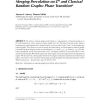Free Online Productivity Tools
i2Speak
i2Symbol
i2OCR
iTex2Img
iWeb2Print
iWeb2Shot
i2Type
iPdf2Split
iPdf2Merge
i2Bopomofo
i2Arabic
i2Style
i2Image
i2PDF
iLatex2Rtf
Sci2ools
RSA
2010
2010
Merging percolation on Zd and classical random graphs: Phase transition
: We study a random graph model which is a superposition of bond percolation on Zd with parameter p, and a classical random graph G(n, c/n). We show that this model, being a homogeneous random graph, has a natural relation to the so-called “rank 1 case” of inhomogeneous random graphs. This allows us to use the newly developed theory of inhomogeneous random graphs to describe the phase diagram on the set of parameters c ≥ 0 and 0 ≤ p < pc, where pc = pc(d) is the critical probability for the bond percolation on Zd . The phase transition is of second order as in the classical random graph. We find the scaled size of the largest connected component in the supercritical regime. We also provide a sharp upper bound for the largest connected component in the subcritical regime. The latter is a new result for inhomogeneous random graphs with unbounded kernels. © 2009 Wiley Periodicals, Inc. Random Struct. Alg., 36, 185–217, 2010
| Added | 30 Jan 2011 |
| Updated | 30 Jan 2011 |
| Type | Journal |
| Year | 2010 |
| Where | RSA |
| Authors | Tatyana S. Turova, Thomas Vallier |
Comments (0)

